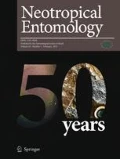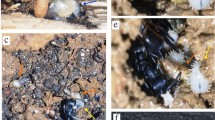Abstract
The Camponotus Mayr genus of carpenter ants is one of the largest in species number and widely represented in the Neotropical Region. Most species are generalists and capable of exploiting diverse habitats including urban environments. Urban green areas can act as a repository of regional biodiversity, thus we investigated whether this is valid for the largest city in South America. We compared the richness of Camponotus spp. in two green areas in regions with distinct urbanization profiles and also with previous surveys made in smaller cities and in natural areas of the original Atlantic Forest. Besides the usual capture of worker specimens, we included capture of alates to improve the species richness sampling. Morphological identification of Camponotus spp. is challenging, even more when alates are included. To assist in specimen identification, we performed DNA sequencing of mitochondrial and nuclear markers. The richness observed in the less stressed urban area was higher than in the more stressed one. Camponotus spp. reported in natural areas are largely represented in the urban area. DNA sequencing for specimen identification is hampered by the lack of corresponding sequences in the GenBank, but it helped to associate workers and alates of the same species and indicated the existence of cryptic species in the genus. Capture of alates allowed detection of several species for which workers were not sampled; therefore, it is a valuable tool for surveying diversity of Camponotus or other ant taxa with arboreal or hypogeic habits.


Similar content being viewed by others
References
AntWeb (2016) Genus: Camponotus. https://www.antweb.org/description.do?rank=genusandname=camponotus. Accessed 22 Aug 2016
Bolton B (2016) An online catalog of the ants of the world. http://antcat.org. Accessed 22 Aug 2016
Borchsenius F (2009) FastGap 1.2. http://www.aubot.dk/FastGap_home.htm. Accessed 22 Aug 2016
Campos-Farinha AEC, Bueno OC, Campos MCG, Kato LM (2002) As formigas urbanas no Brasil: retrospecto. O Biológico 64:129–133
Candek K, Kuntner M (2015) DNA barcoding gap: reliable species identification over morphological and geographical scales. Mol Ecol Resour 15:268–277
Coelho MS, Fernandes GW, Santos JC, Delabie JHC (2009) Ants (Hymenoptera: Formicidae) as bioindicators of land restoration in a Brazilian Atlantic Forest fragment. Sociobiol 54:51–63
Delabie JHC, Jahyny B, Nascimento IC, Mariano CSF, Lacau S, Campiolo S, Philpott SM, Leponce M (2007) Contribution of cocoa plantations to the conservation of native ants (Insecta: hymenoptera: Formicidae) with a special emphasis on the Atlantic Forest fauna of southern Bahia, Brazil. Biodivers Conserv 16:2359–2384
Fisher BL, Smith MA (2008) A revision of Malagasy species of Anochetus Mayr and Odontomachus Latreille (Hymenoptera: Formicidae). PLoS One 3(5):e1787. doi:10.1371/journal.pone.0001787
Floren A, Wetzel W, Staab M (2014) The contribution of canopy species to overall ant diversity (Hymenoptera: Formicidae) in temperate and tropical ecosystems. Myrmecol News 19:65–74
Gusmao FA, Harakava R, Campos AEC (2010) Fire-ants of the Solenopsis saevissima species-group (Hymenoptera: Formicidae) nesting in parks in the city of São Paulo: identification based on mtDNA sequences and morphological characters. Sociobiol 56:353–362
Hajibabaei M, Singer GAC, Hebert PDN, Hickey DA (2006) DNA barcoding: how it complements taxonomy, molecular phylogenetics and population genetics. Trends Genet 23:167–172
Hall TA (1999) BioEdit: a user-friendly biological sequence alignment editor and analysis program for windows 95/98/NT. Nucleic Acids Symp Ser 41:95–98
Hashmi AA (1973) A revision of the neotropical ant subgenus Myrmothrix of genus Camponotus (Hymenoptera: Formicidae). Stud Entomol 16:1–140
Hebert PDN, Cywinska A, Ball SL, DeWaard JR (2003) Biological identifications through DNA barcodes. Proc R Soc Lond B Biol Sci 270:313–321
Hebert PDN, Penton EH, Burns JM, Janzen DH, Hallwachs W (2004) Ten species in one: DNA barcoding reveals cryptic species in the neotropical skipper butterfly Astraptes fulgerator. Proc Natl Acad Sci U S A 101:14812–14817
Janicki J, Narula N, Ziegler M, Guénard B, Economo EP (2016) Visualizing and interacting with large-volume biodiversity data using client-server web-mapping applications: the design and implementation of antmaps.org. Ecol Inform 32:185–193
Kimura M (1980) A simple method for estimating evolutionary rate of base substitutions through comparative studies of nucleotide sequences. J Mol Evol 16:111–120
Longino JT (2002) Camponotus atriceps (Fr. Smith 1858). http://academic.evergreen.edu/projects/ants/genera/camponotus/species/atriceps/atriceps.html. Accessed 22 Aug 2016
Lutinski JA, Lopes BC, Morais ABB (2013) Diversidade de formigas urbanas (Hymenoptera: Formicidae) de dez cidades do sul do Brasil. Biota Neotrop 13:332–342
Mackay WP (2004) The systematic and biology of the new world carpenter ants of the hyperdiverse genus Camponotus (Hymenoptera: Formicidae). http://www.utep.edu/leb/antgenera.htm. Accessed 22 Aug 2016
McArthur AJ, Leys R (2006) A morphological and molecular study of some species in the Camponotus maculatus group (Hymenoptera: Formicidae) in Australia and Africa, with a description of a new Australian species. Myrmecol Nachr 8:99–110
McKinney ML (2002) Urbanization, biodiversity, and conservation. BioSci 52:883–890
Melo TS, Peres MCL, Chavari JL, Brescovit AD, Delabie JHC (2014) Ants (Formicidae) and spiders (Araneae) listed from the metropolitan region of Salvador, Brazil. Check List 10:355–365
Pacheco R, Vasconcelos HL (2007) Invertebrate conservation in urban areas: ants in the Brazilian Cerrado. Landsc Urban Plan 81:193–199
Puillandre N, Lambert A, Brouillet S, Achaz G (2012) ABGD, automatic barcode gap discovery for primary species delimitation. Mol Ecol 21:1864–1877
Rambaut A (2009) FigTree v.1.3.1. Tree figure drawing tool. UK: Institute of Evolutionary Biology, University of Edinburgh
Ribeiro FM, Sibinel N, Ciocheti G, Campos AEC (2012) Analysis of ant communities comparing two methods for sampling ants in an urban park in the city of Sao Paulo, Brazil. Sociobiol 59:971–984
Ronque MUV, Azevedo-Silva M, Mori GM, Souza AP, Oliveira PS (2015) Three ways to distinguish species: using behavioural, ecological, and molecular data to tell apart two closely related ants, Camponotus renggeri and Camponotus rufipes (Hymenoptera: Formicidae). Zool J Linnean Soc 176:170–181
Ronquist F, Teslenko M, van der Mark P, Ayres DL, Darling A, Höhna S, Larget B, Liu L, Suchard MA, Huelsenbeck JP (2011) MrBayes 3.2: efficient Bayesian phylogenetic inference and model choice across a large model space. Syst Biol 61:539–542
Saitou N, Nei M (1987) The neighbor-joining method: a new method for reconstructing phylogenetic trees. Mol Biol Evol 4:406–425
Savage AM, Hackett B, Guénard B, Youngsteadt EK, Dunn RR (2014) Fine-scale heterogeneity across Manhattan’s urban habitat mosaic is associated with variation in ant composition and richness. Insect Conserv Divers 8:216–228
Schmitz A, Riesner D (2006) Purification of nucleic acids by selective precipitation with polyethylene glycol 6000. Anal Biochem 354:311–313
Seifert B (2009) Cryptic species in ants (Hymenoptera: Formicidae) revisited: we need a change in the alpha-taxonomic approach. Myrmecol News 12:149–166
Silva RR, Brandão CR (2010) Morphological patterns and community organization in leaf-litter ant assemblages. Ecol Monogr 80:107–124
Simmons MP, Ochoterena H (2000) Gaps as characters in sequence-based phylogenetic analyses. Syst Biol 49:369–381
Smith MA, Fisher BL, Hebert PDN (2005) DNA barcoding for effective biodiversity assessment of a hyperdiverse arthropod group: the ants of Madagascar. Philos Trans R Soc Lond Ser B Biol Sci 360:1825–1834
Soares NS, Almeida LO, Gonçalves CA, Marcolino MT, Bonetti AM (2006) Levantamento da diversidade de formigas (Hymenoptera: Formicidae) na região urbana de Uberlândia, MG. Neotrop Entomol 35:324–328
Stamatakis A, Hoover P, Rougemont J (2008) A rapid bootstrap algorithm for the RAxML web-servers. Syst Biol 75:758–771
Ströher PR, Li C, Pie MR (2013) Exon-primed intron-crossing (EPIC) markers as a tool for ant phylogeography. Rev Bras Entomol 57:427–430
Suguituru SS, Souza DR, Munhae CB, Pacheco R, Morini MSC (2013) Diversidade e riqueza de formigas (Hymenoptera: Formicidae) em remanescentes de Mata Atlântica na Bacia Hidrográfica do Alto Tietê, SP. Biota Neotrop 13:141–152
Tamura K, Stecher G, Peterson D, Filipski A, Kumar S (2013) MEGA6: molecular evolutionary genetics analysis version 6.0. Mol Biol Evol 30:2725–2729
Thompson JD, Higgins DG, Gibson TJ (1994) CLUSTAL W: improving the sensitivity of progressive multiple sequence alignment through sequence weighting, position-specific gap penalties and weight matrix choice. Nucleic Acids Res 22:4673–4680
Ward PS, Blaimer BB, Fisher BL (2016) A revised phylogenetic classification of the ant subfamily Formicinae (Hymenoptera: Formicidae), with resurrection of the genera Colobopsis and Dinomyrmex. Zootaxa 4072:343–357
Zhang J, Kapli P, Pavlidis P, Stamatakis A (2013) A general species delimitation method with applications to phylogenetic placements. Bioinformatics 29:2869–2876
Acknowledgements
We thank MSc Thiago Ranzani Silva and Rodolfo Probst for helping in specimen comparisons at MZUSP. We thank Dr. Jacques H. C. Delabie for examination of some specimens. We also thank CNPq for the scholarship granted to A.A. Oliveira.
Author information
Authors and Affiliations
Corresponding author
Additional information
Edited by Fernando B Noll – UNESP
Electronic supplementary material
Table S1
(DOCX 24 kb)
Fig S1
Satellite view of the city of São Paulo, showing the study areas Instituto Biológico (IB) and Horto Florestal (HF), located in regions with distinct urbanization profiles. (GIF 1156 kb)
Fig S2
Map of Brazil and of municipalities of the State of São Paulo showing points where specimens were collected. 1 – Curitiba (Paraná State - PR), 2 – Andradas (Minas Gerais State - MG), 3 – Uberlândia (Minas Gerais State - MG), 4 – Fortaleza (Ceará State - CE), 5 – Campo Limpo (CP - São Paulo City), 6 – Instituto Biológico (IB - São Paulo City), 7 – Instituto Federal (IF - São Paulo City), 8 – Horto Florestal (HF – São Paulo City), 9 – Santo André (São Paulo State – SP), 10 – Guarulhos (São Paulo State - SP), 11 – Nazaré Paulista (São Paulo State- SP), 12 – Sorocaba (São Paulo State - SP), 13 – Bragança Paulista (São Paulo State - SP), 14 – Campinas (São Paulo State - SP), 15 – Rio Claro (São Paulo State - SP). (GIF 811 kb)
Rights and permissions
About this article
Cite this article
Oliveira, A.A., Campos, A.E.C. & Harakava, R. Genetic Diversity of Urban Camponotus Mayr (Hymenoptera: Formicidae) Ants Revealed by Capture of Alates and DNA Sequencing. Neotrop Entomol 46, 499–506 (2017). https://doi.org/10.1007/s13744-017-0489-z
Received:
Accepted:
Published:
Issue Date:
DOI: https://doi.org/10.1007/s13744-017-0489-z




